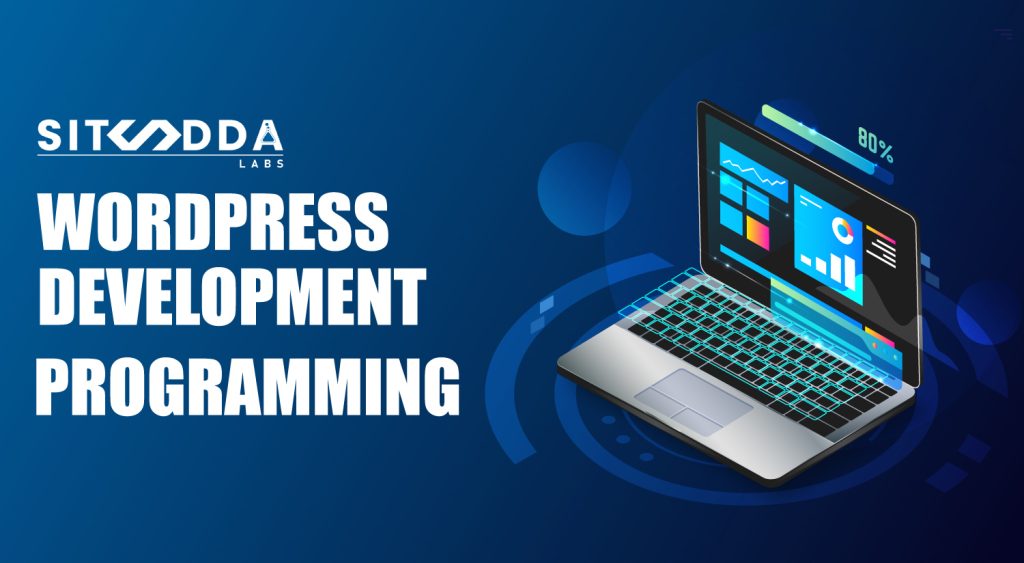WordPress Development Programming
WordPress Development Programming entails using one of the most widely used Content Management Systems (CMS) in the world, WordPress, to create and modify websites. WordPress development gives you the flexibility, scalability, and user-friendliness to create websites, blogs, eCommerce stores, and more.
Here are some key areas involved in WordPress development programming:
1. WordPress Themes Development
- What It Is : A WordPress theme manages a website’s look and design.
- Languages Involved :
- PHP : PHP is used to write WordPress, hence theme development requires a familiarity of PHP.
- HTML : Structure of web pages.
- CSS : Styling and layout of the page.
- JavaScript : For dynamic elements and interactivity.
- Customizing Themes : You have the option of starting from scratch or altering an already-existing theme. WordPress offers theme development rules that specify the files needed, the required templates, and the structure of themes.
- Template Tags : WordPress comes with template tags that let you incorporate dynamic content into your theme from the database, including as titles, posts, comments, and more.
2. WordPress Plugins Development
- What It Is : Plugins are programs that provide your WordPress website new features.
- Languages Involved :
- PHP : To build the plugin functionality.
- JavaScript (sometimes) : For AJAX functions, interactivity, or more complex client-side functionality.
- Creating Plugins :
- Plugins are made up of a core PHP file that defines the plugin and any other files that are required, including image files, JavaScript, or CSS.
- Plugins allow you to add widgets, shortcodes, custom post kinds, and much more.
- WordPress Plugin API : WordPress has a Plugin API that lets you extend and change its behavior by hooking into its fundamental features.

3. WordPress Custom Post Types and Taxonomies
- Custom Post Types (CPT) : Although WordPress has basic post types (such as pages and posts), you may design your own custom post types to manage different kinds of content (such as reviews, testimonials, products, etc.).
- Custom Taxonomies : Although basic taxonomies like as categories and tags are available, you can design your own if you want to organize things more precisely (e.g., genres, departments, types).
4. WordPress Database Interaction (MySQL)
- What It Is : A MySQL database houses WordPress’s data, and you’ll frequently need to work with it to get dynamic material, run custom queries, or perform intricate operations.
- Using WP Database Functions : In addition to the many functions WordPress offers for interacting with the database, such as get_posts(), wp_query(), get_option(), and others, you can also create your own SQL queries if necessary.
- Custom Queries : To extract custom data, particularly when working with custom post types and taxonomies, more complex searches could be required.
5. WordPress REST API
- What It Is : The WordPress REST API allows external applications (like mobile apps or other websites) to communicate with a WordPress site and retrieve or update data.
- Using the REST API :
- Allows developers to interact with WordPress content remotely via HTTP requests (GET, POST, PUT, DELETE).
- Developers can create custom endpoints for the REST API to allow for advanced interaction with WordPress data.
6. WordPress Optimization
- Performance Optimization : Make sure WordPress websites load quickly by reducing the quantity of HTTP requests, optimizing pictures, employing caching, and using less CSS and JavaScript.
- SEO Optimization : WordPress provides tools and plugins (like Yoast SEO) to help optimize websites for search engines. However, developers also play a role in ensuring that the structure of the website is SEO-friendly.
Website Redesign
Redesigning a website entails upgrading the visual design, improving the user experience (UX), and optimizing performance. Whether you’re redesigning an existing WordPress site or developing a fresh look for a new one, the process normally comprises the following steps :
Reasons for a Website Redesign
- Outdated Design : The website’s operation and layout seem outdated or uncompetitive.
- Improved User Experience : Improve user accessibility, readability, and navigation.
- Mobile Responsiveness : If the website isn’t already responsive, make sure it works on mobile devices.
- SEO Optimization : Improved structure, quicker load speeds, and updated content will raise your site’s search engine ranks.
- Rebranding : A new brand identity, logo, or messaging should be included into the website.
- New Features : Include contemporary features like interactive components, e-commerce, and third-party tool integrations.
- Security Upgrades : If the website handles sensitive data, it should be updated to comply with current security standards.

Steps for a Successful Website Redesign
- Planning and Analysis
- Evaluate the Current Website : Find problems like old design, poor UX, or slow loading times.
- Define Goals : Establish defined goals, such as improving user engagement, increasing conversions, or updating the design.
- Examine Competitors : Look through rival websites to find patterns and areas for development.
- Get User Feedback : To learn about the problems that users are facing, use analytics tools or surveys.
2. Content Strategy
- Auditing Current Content : Keep, edit, or delete out-of-date pages.
- Produce New material : Produce original, captivating, and search engine optimized material.
- Organize Information : Make use of a logical hierarchy, classifications, and a clear site architecture.
3. Creating and Testing
- Make Wireframes : Arrange the pages’ structure and arrangement.
- Create Visual Design : Pay attention to contemporary style, color palettes, fonts, and branding components.
- Assure Responsiveness : Create layouts that fluidly change across different devices.
4. Development
- Select a Platform : Choose between custom development and CMS platforms (like WordPress and Drupal).
- Implement Features : Include features like integrations, e-commerce tools, and forms.
- Optimize for Performance : Pay attention to clean code, quick load times, and picture compression.
5. Testing
- Functional Testing : Verify that all links and features function as intended.
- Test for responsiveness : Make sure the website adjusts appropriately across all screen sizes.
- Cross-Browser Testing : Verify compatibility with several browsers, such as Chrome, Firefox, Safari, and others.
- SEO Testing : Ensure metadata, URL structures, and schema markup are in place.
6. Launch and Maintenance
- Pre-Launch Checklist : Before going live, create a backup of the previous website, configure redirects, and do extensive testing.
- Track Performance : To keep tabs on performance, use tools such as Google Analytics and Search Console.
- Regular Updates : With regular updates, you can keep the website safe and the material current.
Benefits of a Website Redesign
- Improved User Engagement : Modern designs and better UX keep visitors on the site longer.
- Enhanced Conversions : Optimized layouts and unambiguous calls-to-action (CTAs) boost revenue and lead generation.
- Improved SEO : Improved content, speed, and structure raise search engine ranks.
- Brand Consistency : Provides a unified consumer experience by reflecting current branding.
- Enhanced Security : Uses updated protocols and software to guard against vulnerabilities.
You may revitalize your online presence, draw in more visitors, and accomplish your company objectives with a well-done website redesign.

